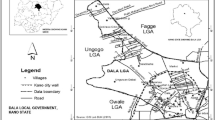Abstract
Katarko village in the Sahel region of northeastern Nigeria relies entirely on natural sources of water such as rainfall and ground water. Thelatter is potentially the only constant source of water. This study is based on primary data collected in Katarko during a period of 8 months in 1996. Analysis indicates that per capita daily water consumption is higher (44.9 l) in the rainy season than in the dry season (26.1 l). The proportion of households who useless than 150 l per day, the minimum daily requirement recommended by the World Health Organization (Dieterich & Henderson, 1963) increases from 29% during the rainy season to 67% during the dry season. Most households prefer to use water of poor quality that is to be found closer to their homes to traveling long distances to or spending extra time at the water sources to obtain good quality water. Poor water quality, appalling sanitation, and unhygienic water-handling practices, particularly during the dry season, contribute to the high incidence of diarrhea in the village.
Similar content being viewed by others
REFERENCES
Adams, W. M. (1986). Traditional agriculture and water use in the Sokoto Valley, Nigeria. The Geographical Journal 152(1): 30-43.
Ajaegbu, H. I. (1995). Indigenous Technologies for Coping with Rural Water Supply and Use Problems in Katarko Village, Yobe State. A study report submitted to the Jos-McMaster Drought and Rural Water Use Research Project, University of Jos, Nigeria.
Briscoe, J., and deFerranti, D. (1988). Water for Rural Communities: Helping People Help Themselves. The World Bank, Washington, DC.
Dieterich, B. H., and Henderson, J. M. (1963). Urban Water Supply Conditions and Needs in Seventy-Five Developing Countries. WHO Public Health Papers, No. 23. World Health Organization, Geneva.
Ezeigbo, H. I., and Ogbukagu, I. K. (1991). Towards improved water supply in the arid regions of Nigeria. In Gadzama, N. M., Adeniji, F. A., Richards, W. S., and Thambyahpillay, G. G. R. (eds.), Arid Zone Hydrology and Water Resources. University of Maiduguri Press, Maiduguri.
Gonzalez, R. M. (1995). KBS, GIS and documenting indigenous knowledge. Indigenous Knowledge and Development Monitor 3(1): 5-7.
Ijere, J. A., and Mailafiya, H. M. (1985). Water resources and supply in Biu L.G.A. of Borno State: Problems and prospects. In Proceedings of International Conference on Arid Zone Hydrology and Water Resources. University of Maiduguri, 23-26 Sept. 1985.
Kendie, S. B. (1996). Some factors influencing effective utilization of drinking water facilities: Women, income, and health in rural North Ghana. Environmental Management 20(1): 1-10.
Lloyd, B., and Helmer, R. (1991). Surveillance of Drinking Water Quality in Rural Areas. Longman Scientific and Technical, Essex, England.
Mabogunje, A. L. (1995) The environmental challenges in sub-saharan Africa. Environment 37(4): 4-35.
Ministry of Water Resources and Rural Development. (1994). Water Supply Coverage: Rural Access. Author, Lagos.
Mu, X., Whittington, D., and Briscoe, B. (1990). Modeling village water demand behavior: A discrete choice approach. Water Resource Research 26(4): 521-529.
Nigeria (1995). Knowledge Attitude and Practice Study in Oshun and Ogun States. Http://odili.net/Nigeria.html
Nigeria Demographic and Health Survey. (1990). Prevalence of Diarrhoea by Age and Region. Http://odili.net/Nigeria.html.
Nwa, E. U. (1978). Water Resource Development, Utilization and Management for Agricultural Production in Nigeria. Samaru Conference, No. 16. Institute of Agricultural Research, Zaria.
Nyong, A. O., and Kanaroglou, P. S. (1997). Demographic Structure of a Northern Nigerian Village. Unpublished Manuscript. School of Geography and Geology, McMaster University, Hamilton, Ont.
Ogezi, A. E., Okechukwu, G. C., and Ugodulunwa, F. X. O. (1996). A Survey of Water Resources of Katarko Village, Yobe State, Nigeria. Research Sub-Project No. 9. Jos-McMaster Drought and Rural Water-Use Research Project, University of Jos, Nigeria.
Pediatric Association of Nigeria (1994). Causes of Child Mortality: Estimated Contribution. Author, Lagos.
Rathgeber, E. (1996). Women, Men, and Water-Resource Management in Africa. Http://www.idrc.ca/books/focus/804/chap3.html.
Sharma, N. P., Damhaug, T., Gilgan-Hunt, E., Grey, D., Okaru, V., and Rothberg, D. (1996). African Water Resources: Challenges and Opportunities for Sustainable Development. World Bank Technical Paper No. 331. The World Bank, Washington, DC.
Sheat, A. (1992). Public Perception of Drinking Water Quality: Should We Care? Paper presented at New Zealand Water Supply and Disposal Association Annual Conference, Christchurch, New Zealand. Quoted in Syme, G. J., and Williams, K. D. (1993) The psychology of drinking-water quality: An exploratory study. Water Resources Research 29(12): 4003-4010.
Tarhule, A. A. (1997). Droughts, Rainfall and RuralWater Supply in Northern Nigeria. Doctoral Dissertation, School of Geography and Geology, McMaster University, Hamilton, Ont.
Tarhule, A. A., and Woo, M.-K. (1997). Characteristics and use of shallow wells in a stream fadama: A case study in Northern Nigeria. App lied Geography 17(1): 29-42.
United Nations. (1988). Nigeria: Case Studies in Population Policy. Department of International Economic and Social Affairs, Population Policy Paper No. 16., United Nations, New York.
Whittington, D., Lauria, D. T., Wright, A. M., Choe, K., Hughes, J., and Swarna, V. (1994). Household Demand for Improved Sanitation Services: A Case Study of Kumasi, Ghana. UNDP-World Bank Water and Sanitation Program. The World Bank, Washington DC.
Whittington, D., and Swarna, V. (1994). The Economic Benefits of Potable Water Supply Projects to Households in Developing Countries. Economic Staff Paper Number 53. Asiandevelopment Bank, Manila.
World Resources Institute. (1994). World Resources 1994-95 A Guide to the Global Environment.Oxford University Press, Oxford.
Rights and permissions
About this article
Cite this article
Nyong, A.O., Kanaroglou, P.S. Domestic Water Use in Rural Semiarid Africa: A Case Study of Katarko Village in Northeastern Nigeria. Human Ecology 27, 537–555 (1999). https://doi.org/10.1023/A:1018739910377
Issue Date:
DOI: https://doi.org/10.1023/A:1018739910377




